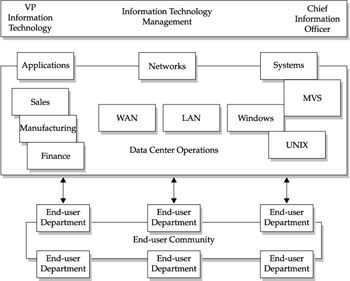Chapter 24: Capacity Planning
| |
Overview
Planning for storage capacity requires the analysis of future end-user demands and the effective management of existing storage resources, both of which support the ongoing processing demands of the business. Provisioning storage can be as simple as adding new storage devices to existing application servers, or as complex as the calculation of new storage demands for supporting a global Internet services application. Regardless of complexity or application, storage demands are end- user driven and reflective of the dynamics within the economics of application usage. For example, an upward trend in sales orders may generate an increase of 100GB of storage to the online application to handle the new business. New customers may almost always spark an increase in storage capacities as the systems expand to handle the customer and related files.
This expansion, and sometimes contraction, of user demands creates the necessity for planning the processing configurations necessary to meet these demands. This chapter brings our cycle of systems management disciplines to the starting point (see the following illustration): the beginnings, development, and/or evaluation of a capacity plan. Capacity planning for storage networks is a subset of overall storage planning, which supports a macro capacity plan for the enterprise, or at least the major components of the data center computer configurations. Consequently, our discussions within this chapter will reflect the support of the entire data-center infrastructure, while articulating the value of developing a capacity plan for storage network infrastructures .

Over time, data centers develop activities and practices necessary to keep up with computing capacities. This is generally referred to as the capacity plan. These practices and activities have matured and congealed into areas of specialization driven by the diversity that exists even in the most conservative IT organizations. These activities are generally divided along physical areas of responsibilities, as well as technological spheres of influence. Figure 24-1 indicates both the physical division of responsibilities within most data centers, as well as the expected technology segregation . This shows applications, systems, and networks as the dominant areas of responsibility. However, supporting the end-user community is generally an operational area that supports end-user computing and help desk functions, and which acts as a conduit of information driven by day-to-day operations of the major areas of specialization (for example, applications, networks, and systems).

Figure 24-1: The traditional division of responsibilities within the data center
Hidden within these organizational divisions are the sometimes invisible spheres of technology influence and expertise. These are characterized by the segregation of the application elite and the back room systems mechanics. This forms the major factions that deal with capacity planning activities. Given that capacity is driven by end-user demands, the application elite is called upon to use their systems analyst skills to communicate end-user future plans in terms that can be translated by the systems mechanics. Within this milieu of communications, the operational front liners form the ad hoc reality-based view of capacity requirements.
Consequently, one of the major segments of this chapter is the discussion of how user requirements can be interpreted properly and used as valid input into the storage planning process. As with any human communications endeavor, this requires a bit of diplomacy and tact to accomplish. Given that storage, and in particular storage networking, is often viewed as a third-level component within the enterprise capacity plan, care and understanding of the communications process provides a certain amount of value in accomplishing a successful storage networking capacity plan.
The importance of integrating storage into a larger plan cannot be overlooked. The need to articulate and justify complete resources (this includes hardware/software, facilities, and the human element) can make the initial enterprise capacity plan (that includes storage) a success. The reason is that storage has often been viewed as a commodity and is purchased in a manner similar to all processing commodities like memory, end-user software, and printers, by cost. However, the storage network changes that significantly, by offering a complete infrastructure that includes the support of multiple processing server configurations. Storage networks can hardly be seen as a commodity, regardless of what vendors want you to think. On the other hand, NAS, although easy to slip through the official capacity planning exercises, often has extenuating effects on other supporting infrastructures within the data center, such as the network.
Finally, the justification of a SAN or NAS configuration based solely on consolidation of storage, servers, or recovery purposes does not make a capacity plan. These can be characterized as internal user requirements that may or may not justify the use of either storage network solution. This is not to say that these are superfluous or self-indulgent requirements; however, they must relate to the business supported by the data center. Justification on a cost basis, which is usually the case for consolidation and recovery strategies, needs to be balanced by a long- term plan to allow the storage infrastructure to grow along with the storage demands of the business.
Also, the establishment of a plan does not dictate its success. The data center must manage the plan. This is especially important with technologies that are volatile, support dynamic growth, and which are critical to an applications success. This is what storage networks are, and thats why they need a storage networking capacity plan of their own. Once integrated into the enterprise plan, and having the confidence of data center management, the storage plan can play a vital and productive role in the long term.
| |
EAN: 2147483647
Pages: 192